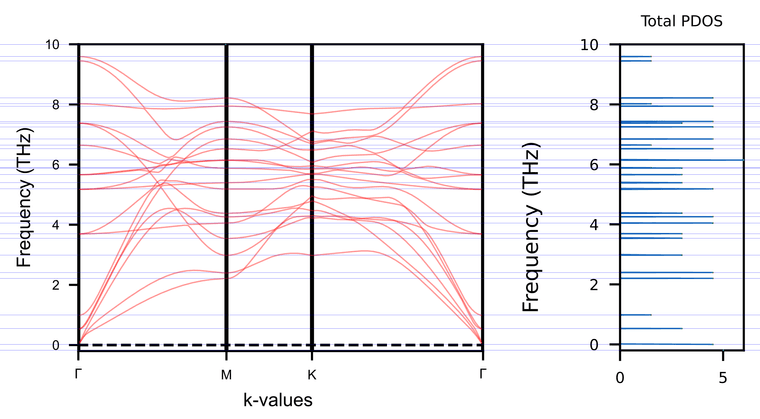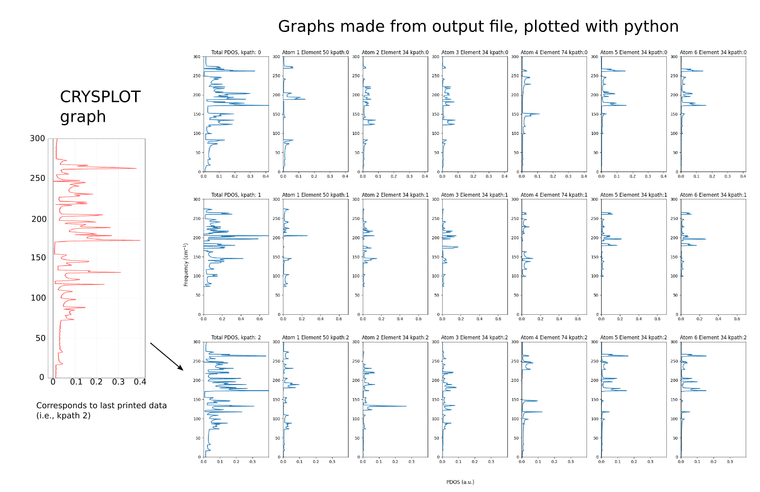Hello Dr. Erba,
Thank you very much for your thorough explanation! This clarifies all my questions. I will make sure to re-calculate using a larger supercell.
Best,
Danny
Hello Dr. Erba,
Thank you very much for your thorough explanation! This clarifies all my questions. I will make sure to re-calculate using a larger supercell.
Best,
Danny
Hello again,
I ran the separate phonon bands and DOS, as recommended. I noticed that the PDOS only shows particular crossings at the Gamma and M points when running them separately, as you can see by the guidelines in the figure below. With PDOS, I was hoping to get information about the entire phonon dispersion, rather than exclusively at these two high-symmetry points. Is there anything that can be done to sample more points in reciprocal space?

Moreover, I analyzed the PDOS from a combined BAND/PDOS calculation again, and I noticed that it gives much more information. These plots seem to show the PDOS for every k-path that is set for bands as you can see from the horizontal lines I plotted, which show the areas with highest PDOS and their corresponding bands for each k-path.

Is it safe to assume that this PDOS correctly corresponds to these paths, or should I be careful when using this method, since it has not been fully tested?
As additional information, I defined my frequency blocks as follows:
Bands only
FREQCALC
DISPERSION
RESTART
BANDS
6 1000
3
0 0 3 0
3 0 2 2
2 2 0 0
ENDFREQ
PDOS only
FREQCALC
DISPERSION
RESTART
PDOS
333 2000
1
ENDFREQ
Combined calculation
FREQCALC
DISPERSION
RESTART
PDOS
333 2000
1
BANDS
6 1000
3
0 0 3 0
3 0 2 2
2 2 0 0
ENDFREQ
Hello Giacomo,
Thank you very much! I had also noticed that both PDOS and BANDS save consecutively to the f25, it makes sense that there might be some issues while writing.
Currently our HPC at MSU is down for maintenance, but I will run BANDS/PDOS separately through RESTART early next week and let you know how it goes.
Also, thanks for the link to the updated tutorial!
Best,
Danny
Hello Prof. Erba,
Of course, here is the input/output:
https://drive.google.com/drive/folders/1qTMFzImOYX69U-E4trT06_WFn90JjcPZ?usp=drive_link
Best,
Danny
Hello CRYSTAL team,
I recently calculated phonon band structures and phonon density of states (PDOS) for a material.
From the output, it seems that the phonon DOS was calculated three times. It is printed in the output once every time a new band path was calculated. In my case, I followed the Gamma-X-Y-Gamma path so it prints PDOS once after Gamma-X, once after X-Y, once after Y-Gamma.
I plotted all of these instances independently (including their atomic projections) using a python script, and they all look different. However, when using CRYSPLOT, it only shows the last calculated PDOS instance as the total PDOS.(see attached figure)

I was wondering if the other two calculated total PDOS are ignored, and how the total PDOS is calculated such that only the last instance is shown. I was hoping to get a better understanding on how the output is organized for future plots.
Thank you,
Danny
Hello Prof. Erba,
Thank you for providing the reference and relevant pages. This is very useful.
Best,
Danny
I wanted to understand better how the Fermi level is determined in CRYSTAL. Looking through the manual, I found that there is mention about this in Section 18.7: "The technique adopted to compute EF and the P matrix in the SCF step is described in reference [100]."
Ref. [100] is the following: V. R. Saunders et al. Electronic structure theory: from molecules to crystals. private communication, 1999.
The only thing I could find about ref. [100] was this google scholar entry which does not have a link to the article. I was wondering if there is any information about this somewhere else, or if you know where we could have access to the original paper.